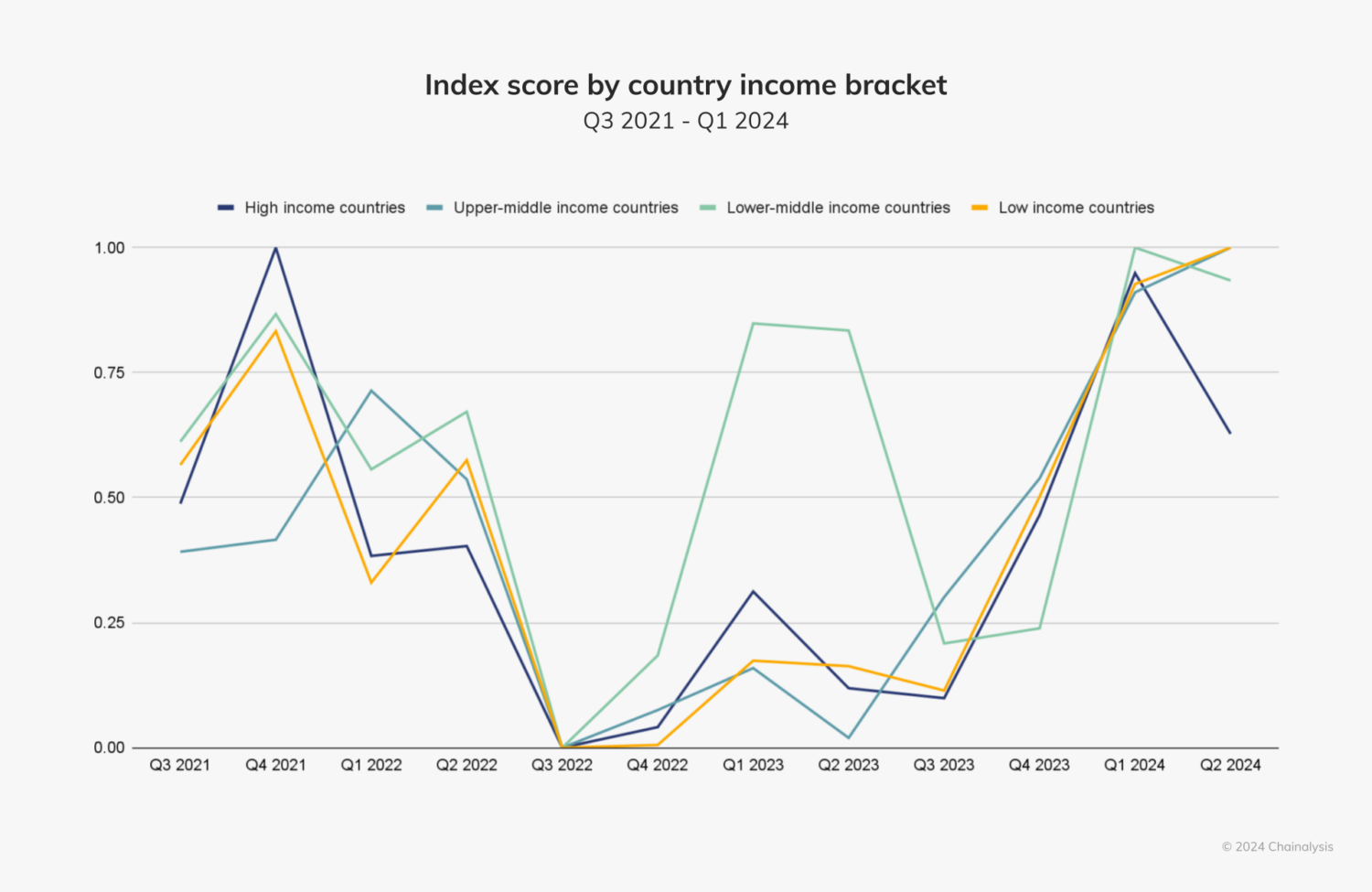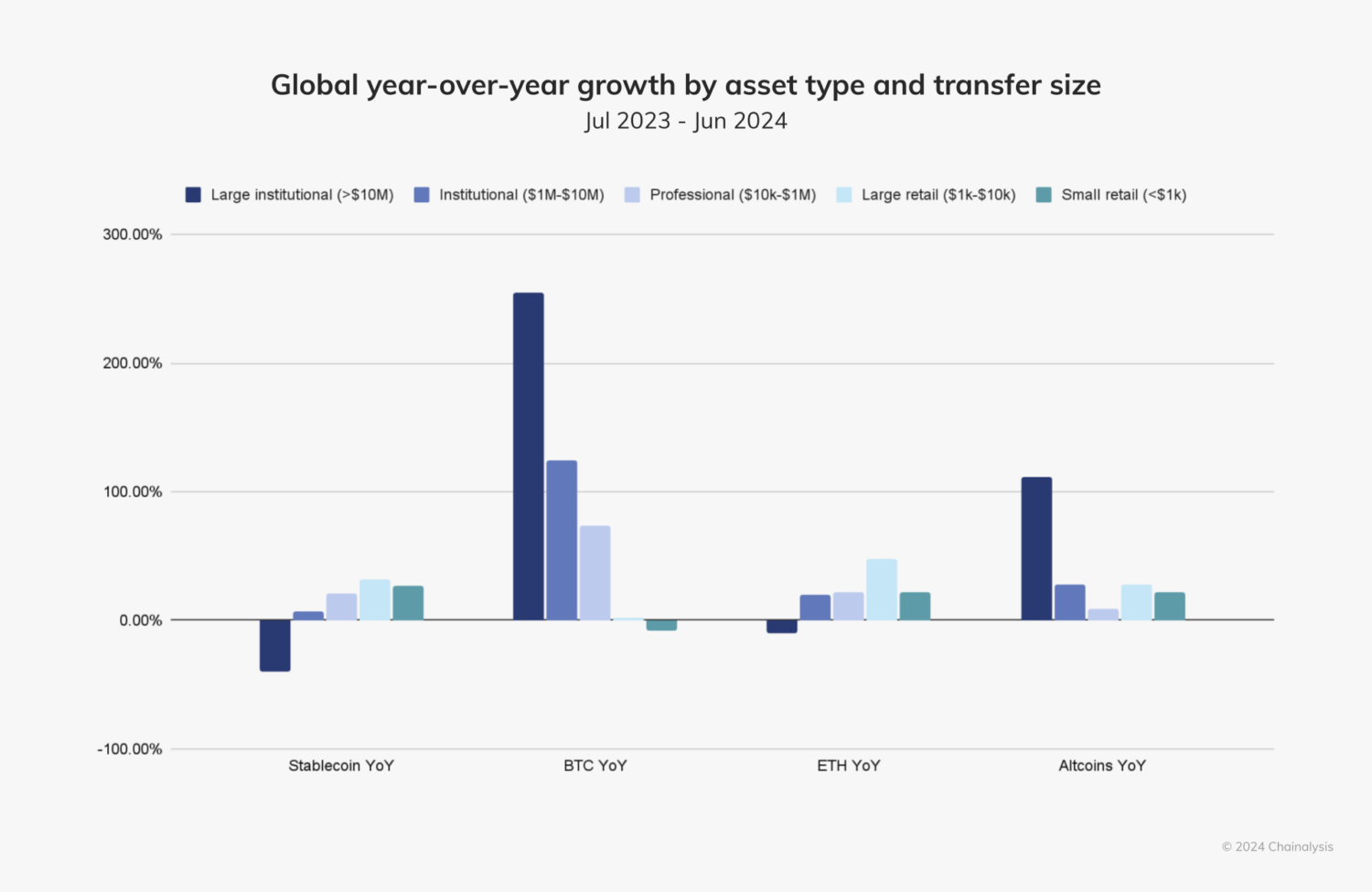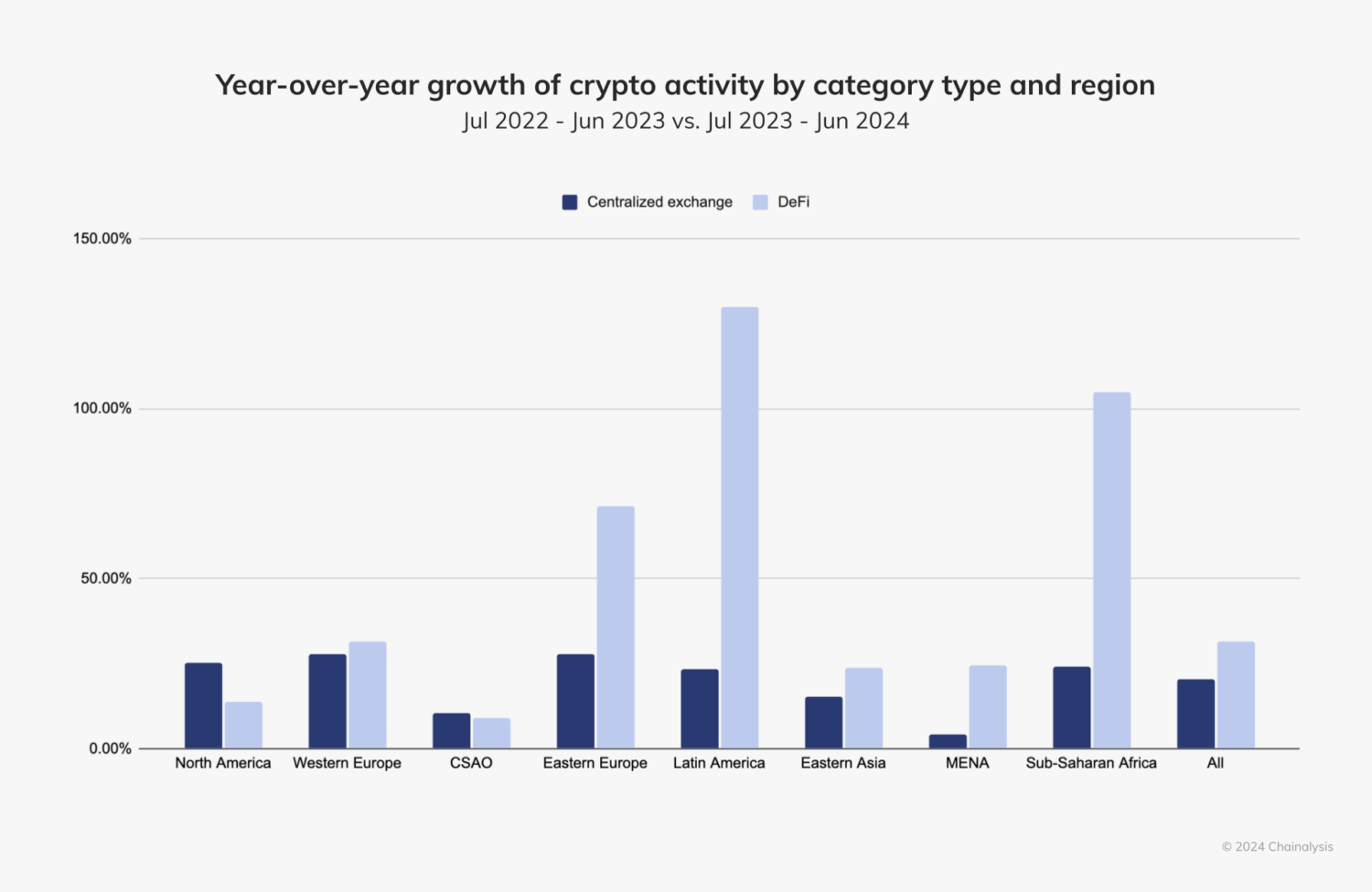This post is an excerpt from our 2024 Geography of Cryptocurrency report. Download your copy now!
We are excited to share the fifth annual Chainalysis Global Crypto Adoption Index. In each year’s report, we look at both on- and off-chain data to determine which countries are leading the world in grassroots crypto adoption. Our research highlights countries where unique cryptocurrency use cases are taking off, and explores why people in countries around the world are embracing crypto.
Keep reading to learn more about:
Our Global Crypto Adoption Index methodology
The Global Crypto Adoption Index consists of four sub-indices, each based on countries’ use of different types of cryptocurrency services. We rank all 151 countries for which we have sufficient data on each sub-index, weight the rankings by characteristics including population size and purchasing power, take the geometric mean of each country’s ranking across all four, and then normalize that final number on a scale from 0 to 1 to give each country a score that determines its overall position. The closer the country’s final score is to 1, the higher the ranking.
To calculate our sub-indices, we estimate countries’ transaction volumes for different types of cryptocurrency services and protocols based on the web traffic patterns of those services’ and protocols’ websites. We acknowledge that web traffic data is imperfect, as some crypto users likely use VPNs and other similar tools to hide their true physical locations. However, given that our index comprises hundreds of millions of cryptocurrency transactions and over 13 billion web visits, it is likely that any erroneous transaction volume due to VPNs is marginal given the size of the data set. We also compare findings with insights from local crypto experts and operators around the world, giving us more confidence in this methodology.
Below are descriptions of the sub-indices and how they are calculated, as well as improvements in our methodology since last year.
Subindex category 1: on-chain cryptocurrency value received by centralized services, weighted by GDP per capita on a PPP adjusted basis
We include this sub-index to rank each country by total cryptocurrency value received on centralized services, and weight the ranking to favor countries where that amount is more significant compared to the average person’s income in that country. To calculate this, we estimate the total value received in the chain by users of centralized services in each country, and weight it by GDP per capita on a PPP-adjusted basis, which measures the country’s income per inhabitant. The higher the ratio of off-chain value received to GDP per capita on a PPP-adjusted basis, the higher the ranking. In other words, if two countries received equal amounts of cryptocurrency from centralized services, the country with a lower weighted GDP per capita would be ahead on a PPP-adjusted basis.
Subindex category 2: on-chain retail cryptocurrency value received by centralized services, weighted by GDP per capita on a PPP adjusted basis
We also estimate the activity of non-professional, individual cryptocurrency users at centralized services, based on the value of crypto they trade compared to the average person’s purchasing power. We do this by estimating the amount of crypto received from centralized services by users in each country – similar to subindex category 1 – but only counting value received in retail-sized transactions, which we designate as transactions under $10,000 crypto. We then rank each country according to this measure, but weight it to favor countries with lower GDP per capita on a PPP-adjusted basis.
Sub-index category 3: on-chain cryptocurrency value received by DeFi protocols, weighted by GDP per capita on a PPP-adjusted basis
We rank countries by their DeFi transaction volume and weight the rankings to favor countries with lower GDP per capita on a PPP-adjusted basis.
Sub-index category 4: on-chain retail cryptocurrency value received by DeFi protocols, weighted by GDP per capita on a PPP adjusted basis
We rank each country by DeFi transaction volume executed in retail-sized transfers (again under $10,000 worth of crypto), weighted to favor countries with lower GDP per capita on a PPP-adjusted basis.
Methodology changes
Methodology change 1: measure DeFi activity
The primary change in this year’s methodology relates to how we measured the value of cryptocurrencies received through decentralized protocols. For DeFi services, we only included the value received from alleged personal wallets and excluded the value received by other known DeFi wallets. This new methodology ensures that the total value received is not inflated due to the intermediary steps required by certain smart contracts.
Here’s an example of how DeFi transfers typically work:
A personal wallet initiates an exchange in DeFi Protocol A, transferring Ether (ETH) from the personal wallet to DeFi Protocol A’s Router contract address. ETH is deposited to the wrapped Ether (wETH) token contract address from the Router contract address. The router contract address receives wETH. A transfer follows from the router to the decentralized exchange (DEX) pool contract. A transfer follows from the DEX pool contract to the router. There is a final transfer from the router back to the personal wallet.
Based on our new methodology, we only count the first transfer in the above example to determine the total value received by the DeFi protocol. By doing this, we can eliminate intermediary transfers between contracts belonging to the same service provider. This process resulted in a decrease in our estimates of value received, but is now a more accurate estimate.
Methodology change 2: P2P exchange sub-index excluded
In previous years, we included P2P cryptocurrency exchange volume, weighted by PPP per capita and number of internet users, to calculate overall Global Crypto Adoption rankings. This year we decided to exclude this sub-index due to a significant decrease in activity on P2P exchanges. One of the largest and most established P2P exchanges, LocalBitcoins.com, shut down last year, contributing to this decline.
The 2024 Global Crypto Adoption Index Top 20
Central and South Asia and Oceania (CSAO) dominates our 2024 index, with seven of the top 20 countries in the region. As we explore in the full report, CSAO has a unique set of crypto markets with high levels of activity on local crypto exchanges, with merchant services and in DeFi.
Country Region Overall index ranking Centralized service value received ranking Retail centralized service value received ranking DeFi value received ranking Retail DeFi value received ranking India CSAO 1 1 1 3 2 Nigeria Sub-Saharan Africa 2 5 2 2 3 Indonesia CSAO 3 6 6 1 1 United States States North -America 4 2 12 4 4 Vietnam CSAO 5 3 3 6 5 Ukraine Eastern Europe 6 7 5 5 6 Russia Eastern Europe 7 11 7 7 7 Philippines CSAO 8 9 8 14 9 Pakistan CSAO 9 4 4 18 13 Brazil LATAM 100 100 10 14 Türkiye Middle East and North Africa 11 14 11 15 11 United Kingdom Central, Northern and Western Europe 12 12 21 9 8 Venezuela LATAM 13 17 16 11 12 Mexico LATAM 14 18 17 13 10 Argentina 13 10 Argentina 13AM 13 10 Argentina 13 10 Argentina 16 15 19 16 Cambodia CSAO 17 10 9 35 23 Canada North America 18 22 26 16 15 South Korea East Asia 19 15 14 33 33 China East Asia 20 20 18 24 22
Global crypto activity is on the rise
Between the fourth quarter of 2023 and the first quarter of 2024, the total value of global crypto activity increased significantly, reaching higher levels than that of 2021 during the crypto bull market. We can see this pattern in the chart below, where we apply our Adoption Index methodology globally by adding all 151 countries’ index scores for each quarter from Q3 2021 to Q2 2024, and re-indexing again to show global adoption growth over time.
Last year, growth in crypto adoption was mainly driven by lower-middle-income countries. This year, however, crypto-activity has increased across countries of all income groups, with a retreat in high-income countries since the start of 2024.

The launch of the Bitcoin ETF in the United States caused an increase in the total value of Bitcoin activity across all regions, with particularly strong year-over-year growth in institutional-sized transfers and in regions with higher income countries, such as North America and Western Europe. On the contrary, year-on-year growth of stablecoins was higher among retail and professional size transfers, supporting real use cases in low-income and lower-middle-income countries in regions such as sub-Saharan Africa and Latin America, in particular. .

Looking at year-over-year growth in terms of types of services, we see that DeFi activity has increased significantly in sub-Saharan Africa, Latin America and Eastern Europe. This growth likely drove an increase in altcoin activity in these regions, as shown in the chart above.

Read our full 2024 Geography of Cryptocurrency report for more information on these trends, recent regulatory developments and how countries around the world are using crypto.
This website contains links to third party websites that are not under the control of Chainalysis, Inc. or its affiliates (collectively “Chainalysis”). Access to such information does not imply association with, endorsement of, approval of, or recommendation by Chainalysis of the Site or its operators, and Chainalysis is not responsible for the products, services, or other content hosted therein.
This material is for informational purposes only and is not intended to provide legal, tax, financial or investment advice. Recipients should consult their own advisors before making these types of decisions. Chainalysis has no responsibility or liability for any decision made or any other acts or omissions in connection with Recipient’s use of these materials. Chainalysis does not warrant or guarantee the accuracy, completeness, timeliness, suitability or validity of the information in this report and shall not be responsible for any claim attributable to errors, omissions or other inaccuracies of any part of such material.
Disclaimer for Uncirculars, with a Touch of Personality:
While we love diving into the exciting world of crypto here at Uncirculars, remember that this post, and all our content, is purely for your information and exploration. Think of it as your crypto compass, pointing you in the right direction to do your own research and make informed decisions.
No legal, tax, investment, or financial advice should be inferred from these pixels. We’re not fortune tellers or stockbrokers, just passionate crypto enthusiasts sharing our knowledge.
And just like that rollercoaster ride in your favorite DeFi protocol, past performance isn’t a guarantee of future thrills. The value of crypto assets can be as unpredictable as a moon landing, so buckle up and do your due diligence before taking the plunge.
Ultimately, any crypto adventure you embark on is yours alone. We’re just happy to be your crypto companion, cheering you on from the sidelines (and maybe sharing some snacks along the way). So research, explore, and remember, with a little knowledge and a lot of curiosity, you can navigate the crypto cosmos like a pro!
UnCirculars – Cutting through the noise, delivering unbiased crypto news







